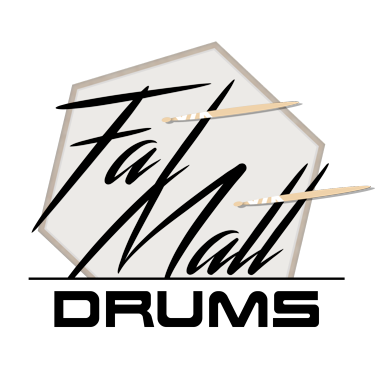Ghost Meat has the bones of an accent tap exercise, but the muscle of a doublestroke exercise and the skin of a singlestrokes exercise. The name was inspired by the notion of “ghost notes” which are the subtle inner beats that add character and direction to an overarching rhythmic figure… it’s always crucial that ghost notes be sweet and low. This warm-up employs solid, monotone slurred ruffs (“pudidahs”) in both ninelet and sextuplet contexts before adding some accents to create true “ghost note” contexts. The bottom half of the piece shifts from the accent-tap focus to a singlestroke rolls focus, and it will require considerable maturity to accurately shift between the ninelet, sixteenth-note, and sextuplet rhythms of the singlestrokes.
Blat
Blat (2010) combines triplestrokes with hugadigs (one-handed breakdown of a flam-tap) and flam rudiments. The more thinly-written middle part centres around what's called the "Cary lick" in the quad line, with a flam accent breakdown in the snare line.
The way the heights are notated, there is a slight difference between the threes of the triplestroke bars, and those of the flam-tap bars, though not every instructor/line makes such a distinction. I think of triplestrokes as being allowed a bit more freedom to rebound, while hugadigs are controlled a bit more to achieve a lower height on the third note (the grace note of the flam-tap).
Double Tap
I wrote Double Tap (2010) on one fine evening when I got stuck on NC State's campus during a snowstorm. They had a showing of Zombieland for students, so after fleshing out this warm-up in the dorms with a couple buddies, it was pretty obvious what I should call it.
It's styled after the very "stock"-sounding double beat warm-ups that generally centre on some sanford-esque pattern, but I wanted to incorporate different hand speeds, as well as an emphasis on the eighth-note pulse within a triplet roll.
While this piece was never used and would prove difficult for a line of typical skill, it is nonetheless worth taking a look at.
High Five (Paradiddles)
High Five (2009) is an all-around doublestroke étude; double-beats, paradiddles, and rolls (slurred and straight) must be mastered in order to pull this one off. This piece is based on an onfield warm-up I wrote with the same name.
The way it is constructed, isolatation and repetition of individual measures will be a useful practice tool in putting together this warm-up. This piece was first performed by the 2009 NC State Drumline.
This one also has double paradiddles, so don't misread the stickings... I know people don't write those too often anymore.
The bass drum part is such that all the written notes could be played as a unison part.
Accent Tap
Accent Tap (2008) is a comprehensive two-height warm-up that covers buck figures, accent-tap contexts, singlestroke figures, and paradiddle figures. It was written with the goal of being part of the NCSU Drumline warm-up repertoire, but John wrote an on-field warm-up with more brevity and focus. This, however, is a good long warm-up to work on accents and taps, with some groovy interludes. It's based on Groovement Movement from the original FatMattDrums, and I think that any level of drumline could find some useful portions to excerpt from it.
East Coast [...]
High Five (Onfield)
This High Five (2007) is the original exercise that the paradiddles warm-up was based on. This version is an onfield warm-up that I wrote while I was in high school. It has a sort of Ditty vibe to it, and it’s big, choppy, and nuts. This was my pride and joy on the very first incarnation of fatmattdrums, and I think it still stacks up pretty well against the rest of my work.








